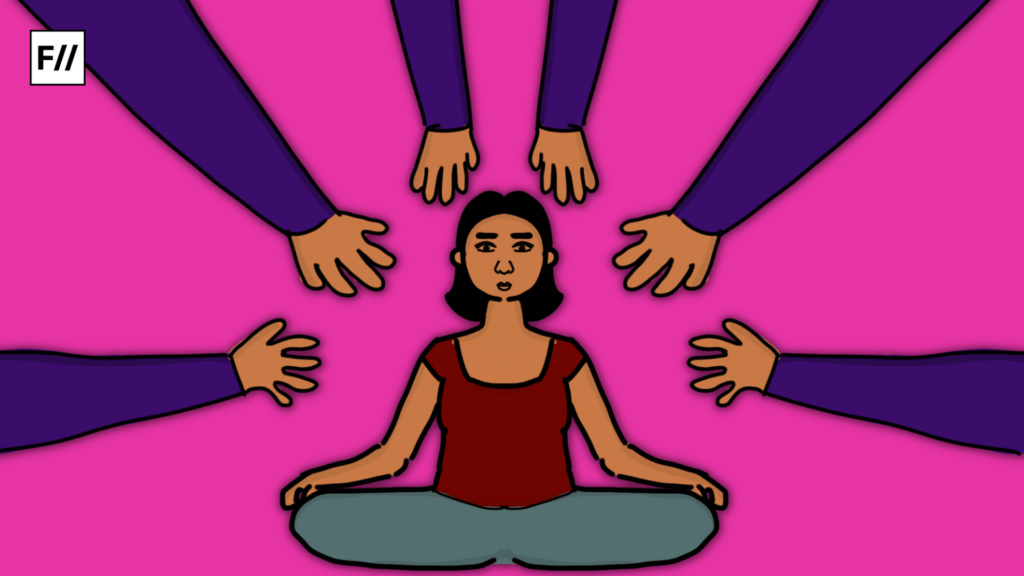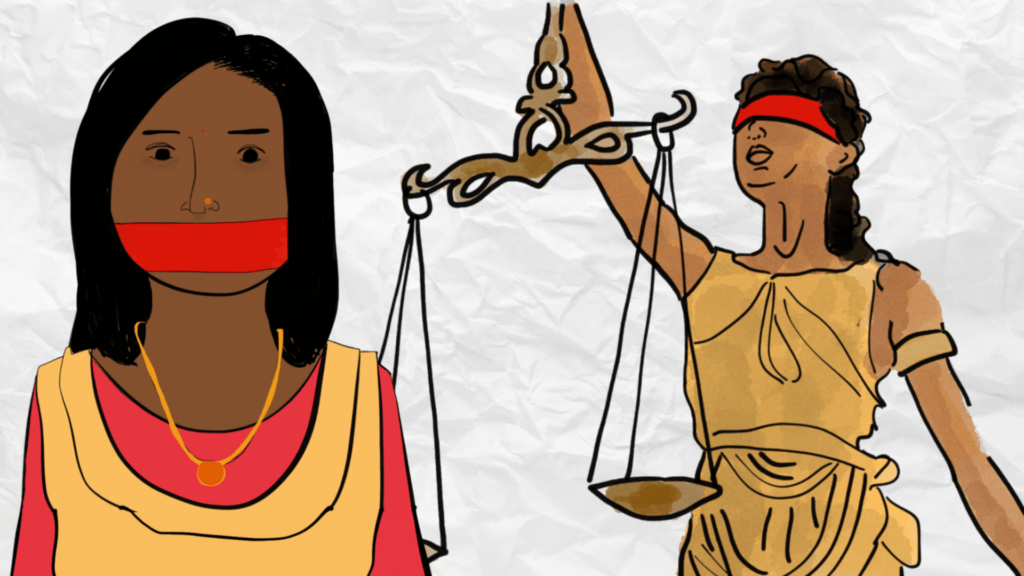Trigger Warning: Violence and Abuse
Violence against women has become a common phenomenon in India. National-level surveys demonstrate time and again that spousal violence and/or violence by the marital family remains the most common cause of violence against women. The National Family Health Survey 2019-21 tells us that over 77% of those who report facing various forms of domestic violence in India, do not seek help or even tell anyone. Unable and unwilling to navigate through the inaccessible, expensive and generally insensitive courts and police, survivors of violence rather opt for strategies in building scope for an eventual exit from the space.
Also Read: Women In Colonised And Partitioned India: Resistance In Everyday Life
While not entirely transformative, such strategies contribute towards better management of violence and some resilience, in a context where absolute justice or peace remains a utopia. From Bina Agarwal’s work in the early 1990s, in rural Kerala to present-day West Bengal, one of the coping strategies that women refer to is control over resources and livelihood.
“Would I have continued to live there with all that torture if I had a place to go? I have been married for 15 years and have struggled for 14 of those years. I don’t have physical strength left or any money. I want a job in some company so that I can bring up my child properly and move from there.”
Shamina Begum
The connection between women’s labour and experience of violence, both intimate and societal is intrinsic. Yet they have operated in silos, hardly ever seen in conjunction. The labouring/productive body of the woman worker is constructed as binary to the nurturing/reproductive body of the woman in domesticity.
Denial of access to livelihood
For many women, marriage ceases their chance to earn a livelihood on their own terms. Women in paid employment report that they face greater violence from their families than women who are not in paid employment. Interestingly, women’s access to skilled higher-paid jobs necessarily did not free them from domestic violence than those in unskilled, low-paid jobs. This does not mean that women who do not have access to paid livelihood do not face violence, rather they do not identify their lack of employment status as a trigger for violence.

Speaking to survivors of violence as well as various stakeholders, it becomes evident, that women’s access to independent earnings is seen as a loss of control by their husbands, partners and in some cases by fathers and brothers too. Women in this study that I carried out, reported various forms of abuse from name-calling to forcibly taking their income away to forcing them to give up their jobs.
Striking from 1909 for their right to suffrage in the USA to 1975 to demonstrate the centrality of their labour in Iceland to the 2015 strike of women tea plantation workers in Munnar, India, against giant corporations and their crony unions, women have time and again fought to reclaim their right to their labour, their right to equality and their right to lives without violence.
India has one of the lowest female labour force participation rates in the South Asian region. This suggests then a lack of access to paid employment for women which in turn denies them the conditions to create economic self-sufficiency. The process is circular. Among various other reasons, women may choose to withdraw from the labour force due to the increase in pressure from their families which in turn then places them in a completely dependent relation to their husbands making them more vulnerable to abuses of various kinds.
Also Read: Domestic Violence And The PWDVA: Its Limitations In The Current Implementation
Women often continue in abusive domestic relations because they have no other means to sustain themselves. Shamina Begum, a woman in her late 40s, from South 24 Parganas says, “Would I have continued to live there with all that torture if I had a place to go? I have been married for 15 years and have struggled for 14 of those years. I don’t have physical strength left or any money. I want a job in some company so that I can bring up my child properly and move from there.”
Livelihood as a coping strategy against violence
Almost paradoxically though women identified access to livelihood as a crucial means of coping, this helped women to avoid the trigger of having to ask money from their abusers, have a semblance of self-dependence to ensure basic sustenance and in some cases even exit these abusive and violent domestic relations.

Gayatri, a woman in her thirties, living in Darjeeling says, “The work of a porter is hard and the pay is low, but it allows me to live a life without violence and hunger.” Ruma from South 24 Parganas was also in her thirties when she walked out of the abusive marriage which had dominated seven years of her life. “At that time I had a young son to support but no earnings and nowhere to go apart from my old parents.” Today as a frontline community organiser for a reputed NGO she tells all the survivors that she works with, about the centrality of livelihood, “paid work is the first and the last thing you need to fight back.”
The question raised by women textile workers of Lawrence Mills in the winter of 1912 remains relevant even today. The question of dignified and equal labour both as workers and as women, the demand for a violence-free life. The appropriation of the day by neo-liberal consumerism must not distract us from prime questions.
While livelihood is indeed a crucial survival strategy for women in abusive relations, sites of work are also not free from violence. Women in paid domestic work, are often in toxic relations in their own homes and are subjected to various forms of exploitation in their workplace. History has recorded that, time and again, women have chosen to flee and escape from their violent domestic spaces, in favour of the unknown worksite making a rational trade-off of their miseries.
Undercounting unpaid labour
India has the highest gap in the time spent on housework by men and women with women accounting for more than 6 hours while men do less than an hour’s housework. The dissociation between labour and domesticity keeps housework unrecognised as labour both materially and rhetorically. There is violence embedded in the complete appropriation of women’s labour in the upkeep of the household. Koyel, a woman with an impaired leg living in Howrah, recounts how she was made to sleep and live in the kitchen by her husband and his family so that she could do cooking and cleaning work. The rest of the family had their bedrooms upstairs.

There is an intrinsic need to recognise the material value of unpaid housework. According to Purnima, a woman in her forties in Bankura, “I have poured myself into maintaining the household for over two decades, and the compensation that the interim order has ordained when I filed a PWDVA case is Rs. 1500; is my time, my labour worth only this much?”
Also Read: Feminism Of Little Things: How Everyday Sexism Contributes To Systemic Gender Oppression
The question raised by women textile workers of Lawrence Mills in the winter of 1912 remains relevant even today. The question of dignified and equal labour both as workers and as women, the demand for a violence-free life. The appropriation of the day by neo-liberal consumerism must not distract us from prime questions. Striking from 1909 for their right to suffrage in the USA to 1975 to demonstrate the centrality of their labour in Iceland to the 2015 strike of women tea plantation workers in Munnar, India, against giant corporations and their crony unions, women have time and again fought to reclaim their right to their labour, their right to equality and their right to lives without violence.
A note to the readers: All the case study details are from The Violent Domestic: Law, its practices and strategies of survival and from the British Academy funded collaborative project on Surviving Violence: Everyday resilience and gender justice in rural-urban India (www.survivingviolence.org).





You have done good research. I think domestic or household job should also be acknowledged and respected as honest labour, equivalent to labour given outside. Changing the mindset might be one of the steps in creating a violence-free environment for all.